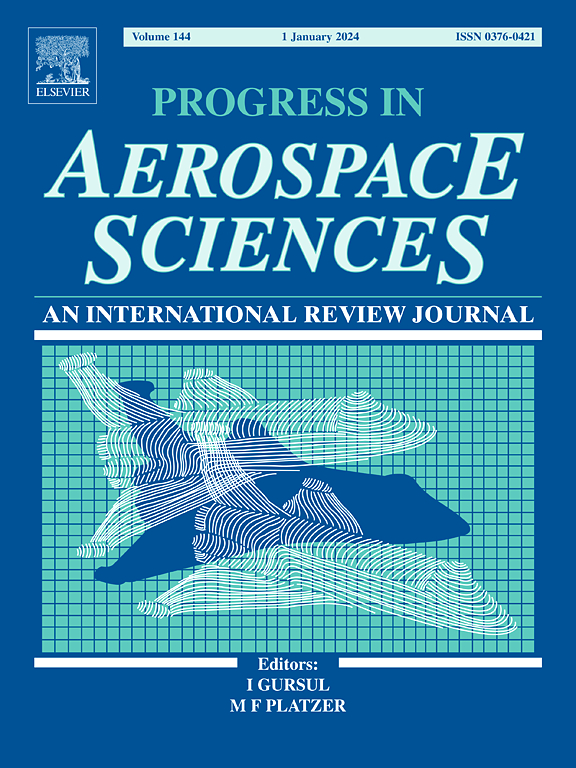扩展现实及其在航空航天工程中的应用综述
IF 16.2
1区 工程技术
Q1 ENGINEERING, AEROSPACE
引用次数: 0
摘要
扩展现实(XR)是一项突破性的技术,正在改变包括航空航天工程在内的各个行业。作为一个领先的领域,航空航天处于采用XR革新其流程和最大化效益的最前沿。这篇综合综述探讨了XR技术的现状、发展和评估方法,以及它们在航空航天工业中的各种应用。该研究首先定义了XR及其组件——增强现实(AR)、混合现实(MR)和虚拟现实(VR)——详细介绍了它们的输入机制,包括触觉、眼球追踪、脑机接口、手势和语音命令,以及数字孪生技术和开发平台(如Unity和虚幻引擎)的集成。然后,它检查评估方法,如工作量评估和态势感知度量,以确保可用性和有效性。XR在航空航天领域的关键应用分为工程(设计和优化、装配和维护、维修和大修)、导航(平视显示器(HUD)、头戴式显示器(HMD)、退化视觉环境(DVE)、视觉系统、空中交通管制(ATC)和城市空中交通(UAM))、培训和模拟(航空和航天)、新兴服务和人工智能驱动的实现。后者包括计算机视觉、识别、姿态估计和使用激光雷达和神经辐射场等尖端技术的3D重建方面的创新。本综述强调了航空航天领域采用XR的进步和挑战,为研究人员、开发人员和行业专业人士提供了全面的资源,旨在利用XR的潜力来提高这一关键领域的安全性、效率和创新。本文章由计算机程序翻译,如有差异,请以英文原文为准。
A comprehensive review of extended reality and its application in aerospace engineering
Extended Reality (XR) is a groundbreaking technology that is revolutionizing various industries, including aerospace engineering. As a leading field, aerospace is at the forefront of adopting XR to revolutionize its processes and maximize benefits. This comprehensive review explores the current state of XR technologies, their development and evaluation methodologies, and their diverse applications across the aerospace industry. The study begins by defining XR and its components - Augmented Reality (AR), Mixed Reality (MR), and Virtual Reality (VR)- detailing their input mechanisms, including haptics, eye-gaze tracking, brain-computer interfaces, gesture, and voice commands, alongside the integration of digital twin technologies and development platforms such as Unity and Unreal Engine. It then examines evaluation methods like workload assessment and situational awareness metrics to ensure usability and effectiveness. Key applications of XR in aerospace are categorized into engineering (design and optimization, assembly, and maintenance, repair, and overhaul), navigation (Head-Up Display [HUD], Head-Mounted Display [HMD], Degraded Visual Environment [DVE], vision systems, Air Traffic Control [ATC], and Urban Air Mobility [UAM]), training and simulation (aeronautical and astronautical), emerging services, and AI-driven implementations. The latter includes innovations in computer vision, recognition, pose estimation, and 3D reconstruction using cutting-edge technologies like LiDAR and Neural Radiance Fields. This review highlights the advancements and challenges of XR adoption in aerospace, providing a comprehensive resource for researchers, developers, and industry professionals aiming to harness XR's potential to enhance safety, efficiency, and innovation in this critical sector.
求助全文
通过发布文献求助,成功后即可免费获取论文全文。
去求助
来源期刊

Progress in Aerospace Sciences
工程技术-工程:宇航
CiteScore
20.20
自引率
3.10%
发文量
41
审稿时长
5 months
期刊介绍:
"Progress in Aerospace Sciences" is a prestigious international review journal focusing on research in aerospace sciences and its applications in research organizations, industry, and universities. The journal aims to appeal to a wide range of readers and provide valuable information.
The primary content of the journal consists of specially commissioned review articles. These articles serve to collate the latest advancements in the expansive field of aerospace sciences. Unlike other journals, there are no restrictions on the length of papers. Authors are encouraged to furnish specialist readers with a clear and concise summary of recent work, while also providing enough detail for general aerospace readers to stay updated on developments in fields beyond their own expertise.
 求助内容:
求助内容: 应助结果提醒方式:
应助结果提醒方式:


